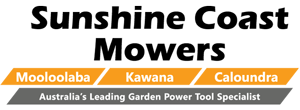If you’ve ever watched a professional use a chainsaw they make operating the machine look pretty easy — start the chainsaw, pull the trigger to accelerate the chain, and cut away. Oh yeah, it might be tricky to get a tree to fall exactly where you want it, but cutting a few branches from smaller trees is a piece of cake, right. Wrong!
Anytime you’re using a chainsaw, no matter how small and trivial the job seems, you must remember that chainsaws are a powerful machine, probably one of the most dangerous, and unfortunately a lot of chainsaw accidents result in serious injuries, especially when users fail to wear the correct protective gear.
“We encourage everyone to think of safety first when using a chainsaw, no matter if you’re a professional or an amateur,” Sunshine Coast Mowers Gerard Cook says. “It is true that a chainsaw has a powerful engine, with razor-sharp teeth and efficient performance to help with a multitude of chores, but only if the operator is fully informed.”
The risks involved in operating a chainsaw makes the need for Personal Protective Equipment, PPE, that much more important, even if you’re not the person operating the chainsaw, if you’re nearby you should be wearing some form of protection, whether that be hearing protection and eye protection.
Other forms of PPE you should wear when operating a chainsaw includes hearing protection, eye protection, chaps, gloves, and sturdy work boots.
Some of the essentials you will need to invest in, which are all available at Sunshine Coast Mowers, is a good pair of boots and gloves — you don't want to be slipping and sliding with a chainsaw in your hands. Also, grab a pair of cut-resistant chaps, and while you're at it, get some ear-protection, and eye protection as well.
It’s also a good idea to refresh your memory. If your chainsaw is new or you have not used it in years, make sure you give yourself a quick refresher course by reading over the manual. If you cannot find the manual, ask us at Sunshine Coast Mowers, we can help familiarise you with your machine.
Our top tips:
- Wear protective gear: No job is too small for protective gear.
- Tune up: Let the team at Sunshine Coast Mowers give your chainsaw a tune-up before you start using it.
- Beware the cold: Just like seasonal road changes, winter causes different operating conditions for cutting. Be extra careful getting your footing to avoid accidental slips.
- Leave it to the pros: never risk your personal safety by trying to tackle a job that is out of your league.
Here are a few more chainsaw safety do’s and don’ts:
DO
- Use ALL PPE,
- Use proper size chainsaw, we recommend the Stihl MS170 MiniBoss for domestic use,
- Use a two hand grip,
- Use secure stance and footing.
DON'T
- Work before sizing up the situation,
- Use poorly maintained saw, see Sunshine Coast Motors for a tune-up first,
- Walk with saw running,
- Leave a tree partially cut and still standing.
One of the biggest tips we can give you is to creating a safe environment. Before you begin any cutting, check the environmental safety of the specific situation. Particularly with felling, look up, look down, look around. Then ask yourself these questions:
- Is there an escape route for you to take for when the tree falls?
- Is there a clear path for the tree to fall?
- Is the tree weakened by bugs or disease?
- Is the wind blowing from the direction that you want the tree to fall?
Don’t be afraid to ask a professional if you are seriously concerned about the risk.
Common names to remember:
- Felling: This is the act of cutting down a tree.
- Limbing: This is removing limbs from the tree before or after it is felled.
- Trimming: (When using a chainsaw) refers to cutting limbs back or taking off branches on a limb.
- Bucking: This is cutting the "log" or trunk of the tree in usable pieces, for instance, fireplace lengths.
